Images
of dry tropical habitat: Mexico: more photos of Bromeliads(Bromeliaceae)
Though often associated
with tropical rain forests, the strange shapes and often epiphytic habits
of bromeliads are wonderful surprises in the tropical dry forest. The Pineapple
Family is only found in the Americas. Click on a thumbnail for a larger
image:
1. 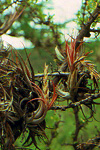 2.
2.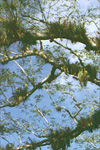 3.
3.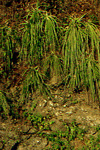 4.
4.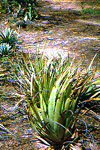 5.
5.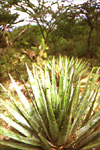 6.
6.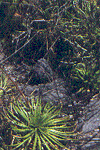
- 1. Most epiphytic bromeliads
in Mexican tropical dry habitats are in the genus Tillandsia. Epiphytic
plants grow on other plants, usually but do not parasitize them. The central
leaves of this species turn red when the flower spike emerges, probably
helping to attrack pollinators. These plants are growing on the twigs of
a large shrub in the genus Lycium, a member of the tomato family
Solanaceae.
- 2. This Enterolobium
tree (Fabaceae) in Tamaulipas, Mexico, is covered with epiphytes, most
of them bromeliads.
- 3. This species of
Tillandsia (?) has the peculiar habit of growing on rock
faces with its soft, floppy leaves weeping downward. In contrast, many
bromeliads have very still leaves.
- 4. - 6. The other
most common genus of bromeliad in Mexican tropical dry habitats is
Hechtia. Unlike Tillandsia, Hechtias grow in the ground. They
are often very substantial, stiff, and prickly, resembling Century Plants
(Agave in the Agavaceae), some of which can be seen as blue rosettes
in the background in photo 3. The Hechtia shown in the foreground
in photo 5. even has cruel recurved spines on the margins of its leaves.
It occurs with the prickly cycad Dioon edule, lots of prickly pear
cactus (Opuntia), and numerous spiny legumes on sharp, channelled
limestone.
home - people -
research - images of the dry
tropics - exploration -
acknowledgements
Instituto de Biología, Universidad Nacional Autónoma
de México
Circuito Exterior s/n, Ciudad Universitaria
Copilco, Coyoacán A. P. 70-367
C. P. 04510, México, D. F.
MÉXICO
(52) 55 5622-9127 fon (52) 55 5555-1760 fax
molson@ibiologia.unam.mx
all material © 2002 Mark E Olson
 2.
2. 3.
3. 4.
4. 5.
5. 6.
6.